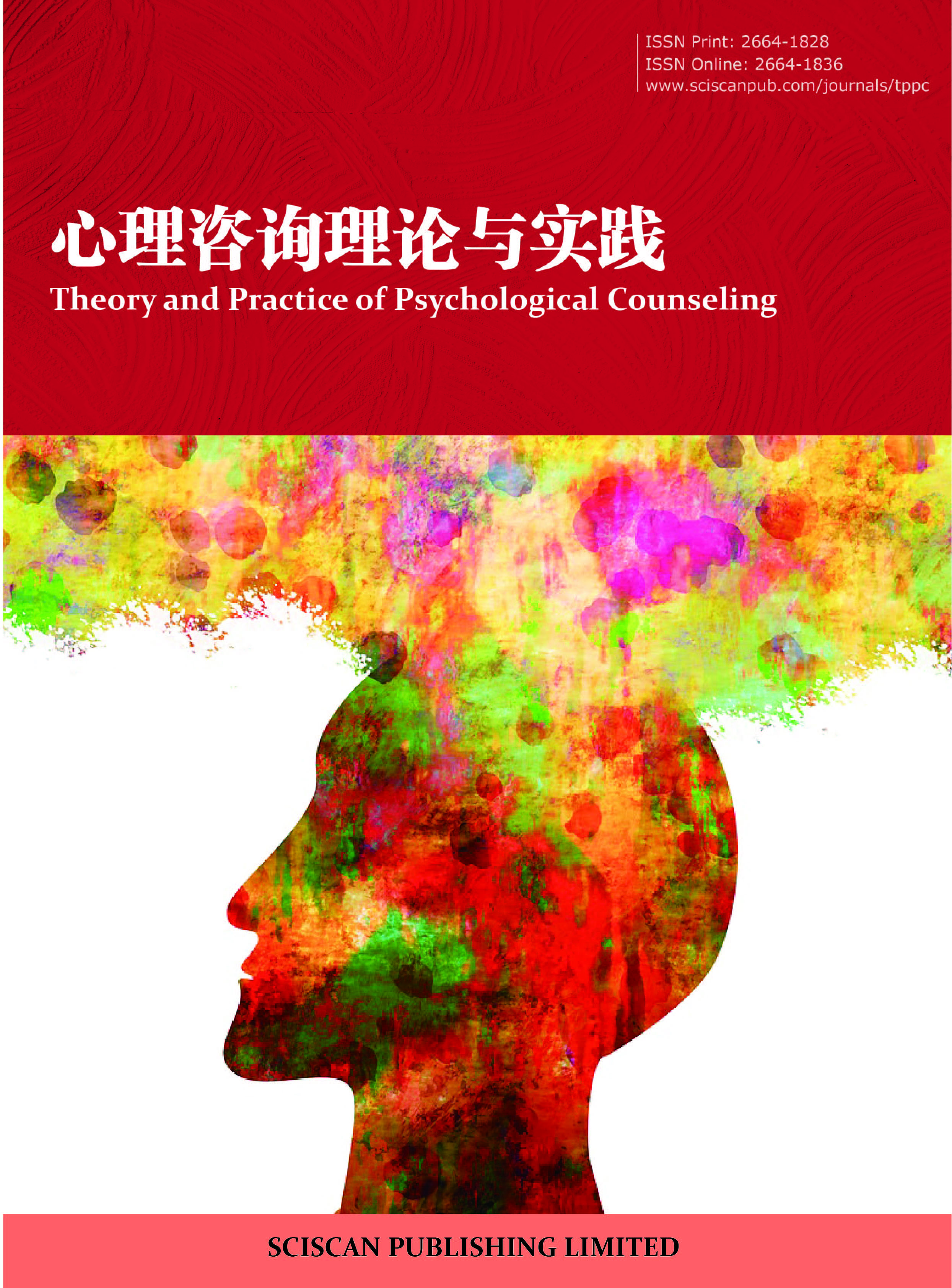Theory and Practice of Psychological Counseling
基于精神分析的虚拟现实暴露疗法 ——以社交焦虑的自助干预为例
Psychoanalysis-based Virtual Reality Exposure (PVRE) -The Self-help Intervention on Social Anxiety Disorder (SAD)
- Authors: 张亚
-
Information:
华东师范大学心理与认知科学学院,上海
-
Keywords:
Social anxiety; Virtual reality (VR); Psychoanalysis-based virtual reality exposure (PVRE); Case study社交焦虑; 虚拟现实技术; 基于精神分析的虚拟现实暴露疗法; 个案研究
- Abstract: Objective: In order to improve the low consultation rates of Social Anxiety Disorder (SAD) and break through the limitation of utilizing Virtual Reality Exposure (VRE) on SAD, our study developed the self-help intervention model of Psychoanalysis-based Virtual Reality Exposure (PVRE) therapy. Method: Based on the psychoanalysis of SAD clients’ objective relationships, we designed the virtual archetypes of their childhood caregivers. During the self-help intervention process, we used these virtual figures to arouse the clients’ inner fear as well as decrease their negative responses. By using the case report, we introduced the core steps and introspection of the PVRE. Result: PVRE might facilitate the effective self-help intervention of SAD, especially for the clients who were reluctant to ask for help and had negative experience with main caregivers during the childhood. Further studies should focus on the clinical improvement of the PVRE with large samples. Conclusion: The combination of different therapeutic theories (e.g., psychodynamic or psychoanalysis orientation) and newly-developed VR techniques might play an important role in self-help intervention of SA or other clinical symptoms. 目的:针对社交焦虑者较少愿意主动寻求帮助的临床干预难点,以及 目前的虚拟现实暴露疗法仅局限于行为训练的不足之处,本研究初步发展了基 于精神分析的虚拟现实暴露疗法。方法:结合新兴的虚拟现实技术以及精神分 析对社交焦虑者心理动力的理解,本研究设计了基于重要养育者原型的虚拟形 象作为干预点,发展了针对社交焦虑者核心恐惧的干预步骤,旨在帮助他们通 过自助练习克服在社交情景下的恐惧、焦虑心理,打破焦虑—回避—更焦虑的 恶性循环,并通过个案分析初步呈现了该工作方法的理念和流程。结果:初步 的个案研究支持了该疗法适用于功能良好但不愿就诊的社交焦虑者进行自助咨 询;后续研究还需要大样本随机对照实验关注该工作方法的临床效果。结论: 精神分析及其他流派与虚拟现实技术结合进行整合干预可能是未来自助咨询的 重点。
- DOI: https://doi.org/10.35534/tppc.0207029
-
Cite:
张亚.基于精神分析的虚拟现实暴露疗法——以社交焦虑的自助干预为例[J].心理咨询理论与实践,2020,2(7):383-395.
https://doi.org/10.35534/tppc.0207029
1 社交焦虑的临床干预难点
社交焦虑障碍(社交恐惧症)(Social Anxiety Disorder,SAD)是指个体在社会交往情景中因被审视或可能面临负面评价而产生的一种明显的、持续的非理性恐惧(DSM-V;American Psychiatric Association,2013)。不同国家的流行病学研究表明,SAD的患病率较高,年患病率达到8%,终身患病率达10%以上,且起病于13—24岁,平均20岁左右,严重影响这个年龄阶段青少年的心理健康发展,此外,SAD也容易引发抑郁症、酒精成瘾以及自杀念头等更为严重的心理问题[1]。
由于社交焦虑者对社交情景的回避行为且他们在与他人交往时伴随着强烈的恐惧和焦虑,他们较少寻求治疗。满足诊断标准的患者获得治疗的比率小于20%;平均寻求治疗的年龄为27—30岁;患者在接受心理健康服务之前通常会被这种障碍折磨达15年以上;深受恐惧或焦虑困扰的人群中愿意接受现场暴露或是想象暴露的患者仅占15%~20%[3]。更重要的是,处于高社交焦虑状态的人群比例在27.2%到42%之间,这些人尽管没有达到社交焦虑障碍的临床诊断标准,却深受不同程度社交焦虑的困扰[4]。在美国,社交焦虑障碍已成为仅次于重症抑郁和酒精依赖的第三大心理疾病。
针对这一在人群中较为普遍存在、寻求帮助率却非常低下的心理疾病,传统的工作方法如暴露疗法、认知行为疗法、基于正念的压力管理方法虽然有不少研究支持其有效性[7],却依然无法克服来访者不愿主动求诊的困难,发展适合这类人群的心理治疗新方法如能打破求诊壁垒将真正使得社交焦虑者获益。
2 基于精神分析的虚拟现实暴露疗法
2.1 针对社交焦虑者进行虚拟现实辅助干预的发展和局限
虚拟现实(Virtual Reality,VR)技术随着计算机软硬件以及网络技术的飞速发展,在最近的二十年里已经在不同的领域里得到了成功的应用。对有心理疾病或障碍的人群来说,他们不愿意去面对现实的体验,VR技术则能为心理医生和患者搭建桥梁,使心理咨询或治疗的开展成为可能。该技术除了早期应用于焦虑障碍的治疗,目前还被广泛应用于创伤后应激障碍、强迫症、躯体形式障碍、进食障碍、精神分裂、成瘾行为等多个新的领域[9]。
在各类焦虑障碍的治疗方面,VR技术自20世纪90年代末期诞生以来就很快应用于心理咨询或治疗领域,发展出虚拟现实暴露疗法(Virtual Reality Exposure,VRE)[10],即通过VR技术模拟患者害怕或焦虑的场景,在治疗师的引导或自助练习的过程中使得患者逐渐、多次暴露于虚拟场景中,通过反复练习克服广场恐惧、社交恐惧、演讲焦虑或针对特定物体的恐惧(如坐飞机恐惧症等)。目前,越来越多的研究支持了社交焦虑患者通过VRE进行反复练习能够显著改善症状,且这种临床改善持续一年以上依然能有效保持,与传统的暴露疗法相比VRE可以同样有效地应用于社交焦虑的干预中[11]。
但是,仅使用VR技术来再现暴露疗法的VRE在干预深度上却容易遭遇瓶颈。以社交焦虑的VRE 干预为例,其主要干预思路是引导社交焦虑者暴露于VR技术模拟的常见社交情景中,如餐厅里、与异性约会以及会议、面试等场景,通过反复练习来改善患者在这些社交情景中的情绪反应,由此迁移到真实的情景中去[14];也有研究者运用虚拟社交场景帮助社交焦虑者进行社交技能训练,他们在研究中设计了一个虚拟的互动伙伴,采用VR技术模拟场景对参与者进行自信训练,同时记录参与者在互动过程中的焦虑状况和生理指标。简而言之,目前VRE的干预思路依然是行为主义思潮下的行为训练法,并没有触及到社交焦虑者恐惧或焦虑的深层心理原因。但是,在目前针对SAD的线下临床干预中,通常整合使用系统脱敏、认知行为疗法、催眠疗法等诸多流派或技术针对个案的特点进行干预,而VR技术目前作为新兴发展的心理咨询辅助技术,仅仅和行为训练(如系统脱敏、场景暴露)相结合,可能在一定程度上限制了自助干预社交焦虑的临床效果。更重要的是,有些个案在社交焦虑方面的行为表现与早期童年经历紧密相连,仅进行行为训练往往治标不治本,有研究表明在针对焦虑症的治疗中,增加探索早年经历影响的干预成分能够改善个案在其他场景中的焦虑,其症状的改善将因此不仅仅局限于考试场景或是社交场景中。鉴于此,探索VR技术与除行为训练之外的其他心理咨询流派相结合的工作方法有重要的临床价值。
2.2 社交焦虑的精神动力学分析
社交焦虑的核心部分是对他人的眼光和评价的恐惧,以及由此引发的焦虑;他人的眼光具有明显的象征含义,正是在他人的眼光里,我们形成了自我的形象、边界以及核心。从客体关系学派的观点来看,社交焦虑者有四个重要的特点,即内在批评的声音(Critical Voice)、被动的呈现(Passive Presence),无法启动(Failure to Launch)以及躲在面具之后(Behind the Mask),这些特点与个案早年缺失足够好的母亲(Good-enough Mother)有关[19]。可以说,重要养育者最早注视的眼光如同一束光,将自我从黑暗中唤醒。这束光是温暖的、可信任的还是冰冷的、怀疑的、挑剔的在很大程度上决定了我们将内在自我与怎样的情绪体验联系在一起,在大脑层面也形成了我们早期的神经网络链接。随着个体的不断成长,个体也会遭遇不同的眼光,各种眼光如同一面面不同的镜子不断丰富着并塑造了个体的外在行为和内在自我。
弗洛伊德(1895)认为,引发焦虑的危险来自幻想中的情景,而这种幻想中的情景通常来自童年早期的经历,如分离、丧失爱、父母的不认可以及愧疚。这些幻想中的情景被儿童视为真正的威胁,让她们觉得无助,无意识的愿望也常常与这些幻想相连,进而引发焦虑[20]。社交焦虑者早期重要养育者或成长过程中的重要他人可能并未给予他们充分信任、肯定以及关爱的眼光,甚至更多是挑剔、不信任或是漠视,这种负性感受可能迁移到其他社交场景中,如出现负面评价恐惧或是难以容忍不确定性[21]。值得一提的是,由于早期重要养育者的目光与小婴儿交互反馈最为频繁,形成了个体内在最早的认知图式以及大脑层面的神经网络链接,如同大厦的基石,即便个体在后来的成长经历中遇到不同的目光,依然会出现选择性的偏差,即注意偏差[1],只能感受到早期的目光模式,而对新的、不同的目光视而不见,或是关注较少。目前有关社交焦虑者内在认知的研究也的确发现他们存在负性认知偏差[22]。
基于客体关系学派对社交焦虑者早年与重要养育者互动品质的关注,我们推测VRE可以进一步拓展其应用范围,通过VR技术帮助社交焦虑者与其早年重要养育者的原型进行互动,从而有机会修复甚至创造与早年重要养育者互动的新体验,提高社交焦虑者使用VRE进行自助干预的临床效果和干预深度。
2.3 基于精神分析的虚拟现实暴露疗法
基于精神分析的虚拟现实暴露疗法(Psychoanalysis-based Virtual Reality Exposure,PVRE)进一步拓展了传统的VRE,突破了行为训练的思路,转而紧扣社交焦虑者恐惧与焦虑的深层心理动力设计了以父亲、母亲、重要他人为原型的虚拟形象,进而引导社交焦虑者直接在虚拟世界中面对早年经历造成的创伤性反应,一方面将社交焦虑者面对他人目光的核心恐惧呈现出来,另一方面也针对这种恐惧唤起早年体验,修复并创造新体验。具体来说,PVRE的自助干预步骤包括以下三个部分:
第一步,引发核心恐惧。根据客体关系学派的观点,社交焦虑者早年重要养育者原型或重要他人的目光,引发最能激发他们回避社交情景的核心恐惧。重要养育者原型包括父亲形象、母亲形象,重要他人形象包括年轻女性、年轻男性等,PVRE根据这些形象拍摄VR视频,来访者需要在虚拟世界里面对这些人,并接受这些形象对自己的考核或面试。来访者可根据自己最为恐惧的目光注视等级进行选择,从易到难进行挑战;咨询师也可在与来访者讨论恐惧感受、追溯童年经历的过程中推荐给来访者合适的练习场景。
第二步,反复练习脱敏。针对核心恐惧的场景,来访者进行反复暴露练习,练习过程包括负向反馈适应练习和正向反馈强化练习。负向反馈适应练习是指社交焦虑者需要反复练习适应虚拟场景中重要他人目光的审视与挑剔(如面对中年女性虚拟形象反复练习接受对方挑剔风格的面试,以克服对母亲原型的恐惧);正向反馈强化练习是指社交焦虑者需要多次暴露在虚拟人物鼓励、注视、积极反馈的目光中,建立新的体验(如面对中年女性虚拟形象,接受对方鼓励式、肯定式的面试反馈和目光接触)。
第三步,创造新体验。一些社交焦虑者在面对他人审视的目光可能会引发强烈的焦虑和恐惧。在进一步的干预设计中,PVRE还安排了一些引发有趣、错愕、开心体验的虚拟场景,如在负向反馈适应练习中以权威形象出现的中年男性形象(父亲原型)在进一步练习中出现了头戴兔子帽的搞笑形象,社交焦虑者需要面对带着兔子帽的中年男性完成面试,通过反复练习,引发他们在原先恐惧的情绪体验中增加有趣、惊奇的成分,从而创造新体验。
总之,PVRE针对社交焦虑者恐惧的核心提供不同的虚拟人物(常见如父亲原型、母亲原型、重要他人原型),通过让社交焦虑者(1)反复练习面对虚拟人物审视挑剔的目光进行负向反馈适应;(2)反复暴露于虚拟人物温和鼓励的目光进行正向反馈强化;(3)尝试以新奇有趣的互动体验取代恐惧焦虑的体验来克服他们在不同社交情景下的回避行为。此外,社交焦虑者还需要在以上虚拟社交情景下练习社交行为,最终在真实世界里尝试有效社交。
3 个案应用与临床反思
PVRE补充VRE干预仅注重行为训练、干预深度不足的局限,既可拓展目前已有的VRE干预思路、提高干预深度,又可作为目前广泛使用的团体认知行为疗法[23]或其他形式面对面咨询的重要补充。有条件的心理咨询师可以将该工作方法作为面谈咨询期间的作业布置给来访者来辅助临床咨询,也可以让不愿主动寻求咨询师协助的社交焦虑者通过相对标准化的在线流程进行心理自助。以下以小A的个案为例,介绍PVRE如何用于社交焦虑者的心理自助中。
3.1 个案背景与主诉问题
小A,女,26岁,公司财务人员,大学毕业工作两年半。两个月前跳槽到新公司负责带领小团队,这个公司虽然薪酬高,但需要每周与公司其他部门主管及公司领导层开晨会介绍本周工作。这对一直以来不善于在权威人士面前展现自己、较为内向的小A来说是个不小的压力,她入职两个月为这个简单的每周一次的晨会汇报工作焦虑不已,甚至在考虑干脆再换个不需要经历这种场合的公司算了。小A在高中大学阶段就是个内向的女生,大学期间除了和同宿舍的同学交往,几乎过着三点一线的生活,要不回家,要不去上课,要不回宿舍。她从小是别人眼中的乖乖女,父亲是工程师,较为拘谨,不苟言笑,母亲是中学老师,对小A比较挑剔,对父亲也管得比较多。小A自己不愿意寻求心理咨询的帮助,觉得自己这么多年都这样过来了,没有什么心理问题,但一想到要因为这个不愿意参加晨会的原因放弃一份薪酬还不错的工作,又和男友吐槽说自己实在有点挫。小A在男友的推荐下进行了自助咨询。
3.2 个案自助咨询过程
小A首先使用信效度良好的社交焦虑量表[24]和常规心理咨询效果评估表[25]自评其社交焦虑程度和心理健康程度,并梳理了对自己影响较大的评价目光,尤其是想到母亲的目光时总觉得自己手脚放在哪里都不对,总是被挑剔、被审视,“像个什么都做不好的傻瓜”。咨询师推荐小A使用为期一周的自助训练,主要训练内容包括以下三个阶段:
(1)选择虚拟人物“中年妇女”形象,代表小A内心深处的母亲原型。每天两次对着该虚拟人物练习汇报自己的工作,可自行选择该虚拟人物以“支持型”或“挑剔型”或“愤怒型”进行反馈。在支持型模式中,虚拟人物会对小A微笑点头,默默赞许;挑剔型模式中,虚拟人物会表现出皱眉、不耐烦或抱胸等身体动作;愤怒型模式中,虚拟人物会表现出愤怒,丢面前的文件夹等愤怒情绪。这个部分的练习主要让小A进行暴露脱敏,从原型深处适应她最恐惧的形象会有不同的反应。
(2)根据小A在练习时的反馈,小A在面临虚拟人物“愤怒型”反馈时最难以进行工作汇报,会出现“不想再练习了,不想看到这张脸”的念头;甚至几次出现“要立即摘下眼镜,结束这个体验”的回避行为,在这个反馈模式下,小A能够汇报的内容最为不连贯,情绪体验也最为糟糕(焦虑和恐惧指数都达到了8分及以上)。根据这个反馈,为小A推荐了创造新体验的幽默版中年妇女形象,在这次体验中,小A面临的虚拟中年妇女形象还是一脸愤怒,会摔文件夹等,但她满头夹着发夹,发夹上出现各种颜文字或搞笑小人,小A面对这个虚拟人物一方面觉得紧张,另一方面也觉得搞笑,经过反复练习,帮助小A克服在虚拟人物愤怒型反馈时的困难。
(3)根据小A每次练习后的自评满意度,在连续四天的反复练习后,小A能够顺畅流利地面对虚拟人物(中年妇女)不同的反馈(支持型、挑剔型和愤怒型)进行工作汇报。根据这个反馈,我们继续为小A在线推荐了工作会议的虚拟场景,该场景模拟了在会议室开会的情景,参与者包括中年妇女,中年男性,年轻同事等,是公司常见的会议场景模拟,小A需要继续练习在该虚拟会议场景中进行工作汇报,直到小A对自己的表现满意为止。
经过一周的反复练习,小A从自己最恐惧的目光——中年妇女所代表的母亲原型开始,逐渐克服对这种目光的恐惧,进而在虚拟会议情景下练习工作汇报,并在这一周的干预期间已经尝试在公司晨会上进行汇报,实际场景下的焦虑和恐惧显著降低。一周的自助干预结束后,小A自述这已经不再是困扰她的问题了,通过SPIN和CORE-OM量表进行再次自评,其得分与一周前相比明显降低。值得一提的是,小A的整个干预过程是在线完成的,咨询师通过在线聊天软件与小A进行文字沟通,并根据小A的反馈为其推荐下一个模块、发送自评量表,小A并不需要走进咨询室,也未见过咨询师真人。
4 个案反思与讨论
由以上案例可见,PVRE并未花费时间与来访者逐一梳理过往经历对个体社交行为的影响,但基于精神分析对社交焦虑症状的理解,通过VR技术将这种理解反应在整个干预过程中,帮助社交焦虑者从内在重要养育者的原型出发逐步克服已经迁移到不同社交情景中的恐惧。本个案有较好的干预效果一方面取决于小A对于干预方案的配合度较高,愿意按照约定完成VR练习;另一方面,小A本身具有良好的社会功能,除社交焦虑外并未伴随其他心理问题,良好的功能水平本身即能预测较好的干预效果[27]。
以上仅介绍了PVRE在个案中的应用,该方法应用于社交焦虑者自助干预的临床效果还需要大样本的随机对照试验以及效果评估数据的支持。目前看来,PVRE的局限可能有两点:其一,自助干预可能仅适用于整体功能较好的社交焦虑者,需排除其他共病的可能;诊断不当时使用PVRE进行自助干预可能会延误患者的就诊时机;其二,无法避免VR晕动症的限制,即长时间沉浸在VR世界中,有些人会感到恶心、头晕,严重的甚至会呕吐休克[28],虽然有一系列减少VR晕动症的方法,但的确会产生晕动症的社交焦虑者可能会因此丧失持续练习的动力。
总之,对于就诊率低、发病率高的社交焦虑症而言,结合VR技术发展干预效果明显且持久的心理自助方法具有重要的临床意义。PVRE基于精神分析,尤其是客体关系学派对于社交焦虑症状成因的理解,对基于行为训练的VRE进行了重要的补充,即通过引导社交焦虑者与重要养育者的虚拟原型进行互动,创造新体验,甚至修复早年创伤带来的幻想中的威胁反应(弗洛伊德语),该工作方法在一定程度上拓展了VR技术辅助心理咨询的可能性。可以预期,经过仔细的设计,未来的VR技术不仅可以和基于行为主义的暴露疗法、系统脱敏、社交技能训练相结合,也可以基于精神分析对于心理疾病病因学的理解,创设可能的修复环境,应用于社交焦虑以及更多心理问题的自助干预中。
参考文献
[1] 钱铭怡,陈曦,钟杰.社交焦虑个体的注意偏差[J].中国临床心理学杂志,2004,12(4):424-426.
[2] Kessler RC,McGonagle KA,Zhao S.Lifetime and 12-month prevalence of DSM-III-R psychiatric disorders in the United States:results from the National Comorbidity Survey[J].Archives of general psychiatry,1994,51(1):8-19.
https://doi.org/10.1001/archpsyc.1994.03950010008002
[3] Foa E B,Cahill S P,Boscarino J A,et al.Social,psychological and psychiatric interventions following terrorist attacks:recommendations for practice and research[J].Neuropsychopharmacology,2005,30(10):1806-1817.https://doi.org/10.1038/sj.npp.1300815
[4] 李静,魏晓宇,黄娅,等.大学生寝室人际信任自尊与社交焦虑关系分析[J].中国学校卫生,2015,36(8):1173-1176.
[5] Pontillo M,Guerrera S,Santonastaso O,et al.An overview of recent findings on social anxiety disorder in adolescents and young adults at clinical high risk for psychosis[J].Brain Sciences,2017,7(10):1-9.
https://doi.org/10.3390/brainsci7100127
[6] Kessler R C,Berglund P,Demler O,et al.Lifetime prevalence and age-of-onset distributions of DSM-IV disorders in the National Comorbidity Survey Replication[J].Archives of General Psychiatry,2005,62(6):593-602.https://doi.org/10.1001/archpsyc.62.6.593
[7] Goldin P,Morrison A S,Jazaieri H,et al.Group CBT versus MBSR for social anxiety disorder:a randomized controlled trial[J].Journal of Consulting and clinical psychology,2016,84(5):1-33.
https://doi.org/10.1037/ccp0000092
[8] Hambrick J P,Weeks J W,Harb G C,et al.Cognitive-behavioral therapy for social anxiety disorder:supporting evidence and future directions[J].CNS Spectrum,2003,8(5):373-383.
https://doi.org/10.1017/S1092852900018630
[9] 马前广,杨晓哲.虚拟现实技术在心理治疗中的进展、争议与展望[J].心理咨询理论与实践,2019,1(5):212-231.
[10] Parsons T D,Rizzo A A.Affective outcomes of virtual reality exposure therapy for anxiety and specific phobias:A meta-analysis[J].Journal of Behavior Therapy and Experimental Psychiatry,2008,39(3):250-261.
https://doi.org/10.1016/j.jbtep.2007.07.007
[11] Anderson P L,Price M.Virtual reality exposure therapy for social anxiety disorder:a randomized controlled trial[J].Journal of consulting and clinical psychology,2013,81(5):751-760.https://doi.org/10.1037/a0033559
[12] Owens M E,Beidel D C.Can virtual reality effectively elicit distress associated with social anxiety disorder[J].Journal of Psychopathology and Behavioral Assessment,2014,37(2):296-305.
https://doi.org/10.1007/s10862-014-9454-x
[13] Bouchard S,Dumoulin S,Robillard G,et al.Virtual reality compared with in vivo exposure in the treatment of social anxiety disorder:a three-arm randomized controlled trial[J].The British Journal of Psychiatry,2017,210(4):276-283.https://doi.org/10.1192/bjp.bp.116.184234
[14] Wallach H S,Safir M P,Barzvi M.Virtual reality cognitive behavior therapy for public speaking anxiety:a randomized clinical trial[J].Behavior Modification,2009,33(3):314-338.
https://doi.org/10.1177/0145445509331926
[15] Stupar-Rutenfrans S,Ketelaars L E H,Van Gisbergen M S.Beat the Fear of Public Speaking:Mobile 360° Video Virtual Reality Exposure Training in Home Environment Reduces Public Speaking Anxiety[J].Cyberpsychology,Behavior and Social Networking,2017,20(10):624-633.
https://doi.org/10.1089/cyber.2017.0174
[16] Reichenberger J,Diemer J,Zwanzger P,et al.Social skills training in virtual reality for social anxiety:validation of relevant interaction situations[J].Zeitschrift Fur Klinische Psychologie und Psychotherapie,2017,46(4):236-247.https://doi.org/10.1026/1616-3443/a000444
[17] Stravynski A.Fearing others:the nature and treatment of social phobia[M].Cambridge:Cambridge University Press,2007.https://doi.org/10.1017/CBO9780511618727
[18] Prochaska J O,Norcross J C.Systems of psychotherapy:A transtheoretical analysis[M].Boston,Massachusetts:Cengage Learning,2013.
[19] McEvoy B,O’Connor J,McCarthy O.Behind the mask:a psychodynamic exploration of the experiences of individuals diagnosed with social anxiety disorder[J].Psychodyn Psychiatry,2016,44(4):541-565.
https://doi.org/10.1521/pdps.2016.44.4.541
[20] Alnaes R.Social phobia:Research and clinical practice[J].Nordic Journal of Psychiatry.2001,55(6):419-425.https://doi.org/10.1080/08039480152693327
[21] 彭顺,汪夏,牛更枫,等.负面评价恐惧对社交焦虑的影响:基于社交焦虑的认知行为模型[J].心理发展与教育,2019,35(1):121-128.
[22] Kimbrel N A,Nelson-Gray R O,Mitchell J T.BIS,BAS,and Bias:the role of personality and cognitive Bias in social anxiety[J].Pers Indiv Diff,2012,52:395-400.https://doi.org/10.1016/j.paid.2011.10.041
[23] Hambrick J P,Weeks J W,Harb G C,et al.Cognitive-behavioral therapy for social anxiety disorder:supporting evidence and future directions[J].CNS Spec,2003,8(5):373-383.https://doi.org/10.1017/S1092852900018630
[24] Connor KM,Davidson JRT,Churchill LE,Sherwood A,Foa E et al.Psychometric properties of the Social Phobia Inventory (SPIN)[J].British Journal of Psychiatry,2000,176,379-386.http://doi:10.1192/bjp.176.4.379
[25] Evans C,Mellor-Clark J,Margison F,Barkham M,Audin K et al.CORE:Clinical outcomes in routine evaluation[J].Journal of Mental Health,2000,9,247-255.http://doi:10.1080/ jmh.9.3.247.255
[26] Zhang Y,Hu J,Evans C,Jin LW,Wu MY et al.Psychometric properties of the Chinese version of the clinical outcomes in routine evaluation-outcome measure (CORE-OM)[J].British Journal of Guidance and Counseling,2020,48k 289-299.http://doi:10.1080/03069885.2019.1682120
[27] Castonguay L G,Beutler L E.让心理治疗生效的实用原则[M].上海:上海教育出版社,2017.
[28] 浙江大学心理与行为科学系李峙研究组,腾讯研究院S-Tech工作室.身临其境:那些被VR影响的心灵、身体与社会[M].上海:上海教育出版社,2018.
















